Our recent piece about distilled and filtered water seems to have triggered some interest in the subject in general. As we’ve hinted before, there’s a vast amount of dangerous misinformation about water washing around the Internet. Much of this propaganda is designed to sell you various kinds of special (and expensive) bottled waters or devices to remove alleged evil substances from the stuff coming out of your tap.
With some non-trivial exceptions, in the main it’s safe to say that what comes out of municipal taps in developed nations is entirely safe to drink. For a very full—and fascinating—rundown on the subject, it’s definitely worth watching “Professor Dave’s” YouTube series “Lies People Tell About Water“.
Water drinking is a habit to be encouraged. But it’s easy to find yourself falling short of your recommended two litres per day. If plain tap water doesn’t entice you there’s a way you can make it more palatable without having to add sugary cordials. We’ve been dipping our toes (figuratively) further into the H20.
But this time with added CO2.
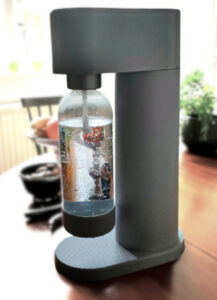 THE CHRISTMAS BREAK GAVE us a chance to test one of the latest donations to Tested Technology. The MySoda Woody (this wouldn’t have been my choice of product name, but the manufacturers are Finnish) is a very simple device—with the exception of a USB cord we sang the praises of back in 2016, probably the simplest ever to grace these pages. No electronics, in fact no electricity.
THE CHRISTMAS BREAK GAVE us a chance to test one of the latest donations to Tested Technology. The MySoda Woody (this wouldn’t have been my choice of product name, but the manufacturers are Finnish) is a very simple device—with the exception of a USB cord we sang the praises of back in 2016, probably the simplest ever to grace these pages. No electronics, in fact no electricity.
What it does is make water fizzy.
As a child I remember the family’s classic soda syphon, a handsome large bottle strapped with silver braid and topped by a shiny tap operated with a lever. The grownups squirted it into their whisky; I used it to turn the oozy purple cordial from the Vimto bottle into a refreshing, bubbly concoction containing—the label assured my parents—”Vitamin D, needed for normal growth and development of bone in children”.
(My own curiosity was roused by the sodium benzoate used as a preservative, which sounded really sciency).
That particular soda syphon had to be taken back to the shop for refilling, a service that was quickly falling into disuse. Newer models could be filled with tapwater and subsequently gassed at home with a small replaceable CO2 capsule that screwed into the top.
The MySoda follows the much later design idea that separates the delivery bottle from the gassing mechanism altogether. The bottle is made of strong, transparent polycarbonate with an air-tight screw top. The gassing mechanism (I’ll call it the gasser) is an elegant stand into which you screw the bottle once it’s been three-quarters filled with plain water. The stand conceals a replaceable 60L CO2 compressed gas bottle of industry-standard size and design.
It would be more accurate to describe it as a 425g cylinder, referring to the weight of CO2 it contains. If you stand the MySoda Woody on a kitchen scale you can get a good idea of the depletion rate as you empty the cylinder.
Assembling the Woody
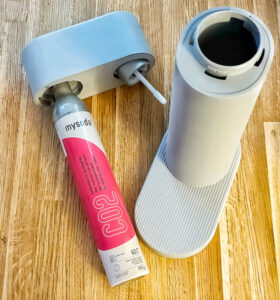 The device arrived at Tested Technology in three main parts:
The device arrived at Tested Technology in three main parts:
- The base unit, which houses the replaceable CO2 cylinder.
- The head unit, which links the cylinder with the water bottle and contains the valves for user control of the gas flow.
- The replaceable cylinder.
The base unit and the head unit comprise what I’ve been calling the gasser. A single 1L water bottle is also included. (Like the CO2 cylinder, this capacity is misleading. You can use it to fizz approximately two-thirds of a litre of tap water.)
The CO2 cylinder’s valve head is protected by a plastic cap which needs to be removed before you screw the cylinder into the head unit. You can then drop the combined head unit and cylinder into the base unit. A clockwise quarter turn locks it into place with a click.
The Woody in Action
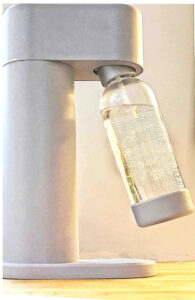
The bottle is screwed in at an angle and is then pushed into the vertical.
MySoda recommends hand washing the 1L water bottle with washing-up detergent before and between each use, carefully rinsing it out afterwards. Then fill it with plain water up to the level indicated on the bottle.
Cold water absorbs CO2 better, so you might want to cool the filled bottle in the fridge before attempting carbonation. But water direct from the cold tap works well enough. Don’t be tempted to add cordial to the water at this stage—the MySoda Woody is only designed to carbonate plain water.
A short, counter-clockwise twist screws the bottle of plain water into the gasser at an angle of about 15º from the vertical. At this stage the gassing mechanism is still locked. To unlock it, you push the bottle towards the body of the gasser until it’s vertical. Now you can activate the button at the top of the gasser, which releases CO2 from the cylinder.
There’s no volumetric or time mechanism monitoring this gas release—how much CO2 you pump in depends entirely on how long you hold down the button or how many button pushes you give it. The MySoda manual suggest two to three short bursts.
The process could hardly be simpler, although it may take a little practice to get used to the “twist-n-push” installation of the bottle. It’s quite safe because no gas can be transferred until the bottle is correctly positioned.
Material Factors
A key selling point of the Woody (the clue’s in the name) is the material used in its manufacture. It’s true that the clear bottle provided with the device is made from planet-unfriendly oil-derived polycarbonate—almost inevitably, as glass would need to be very heavy to prevent shattering under pressure. But the gasser itself is built from a biocomposite obtained from sustainably managed forests.
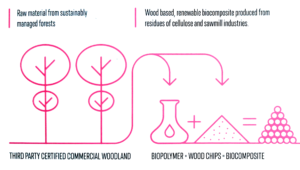
Sawmills produce as a byproduct tons of woodchips. Less obviously, it’s possible to derive some useful natural polymers from wood. Polymers are materials comprising long molecular chains, giving trees the strength to grow tall and the flexibility to withstand winds. Biopolymers, as this class of polymers is called, have many of the properties of synthetic polymers (as used for the polycarbonate 1L water bottle) with the important difference that they are non-toxic and biodegradable.
The material of the MySoda Woody is a combination of woodchips and biopolymers, a naturally-sourced plastic material that won’t pollute the planet. The use of biocomposites is an encouraging trend we hope to see a lot more of in the future.
Niggles
In the early stages we did run into one problem that can happen if the gas cylinder hasn’t been tightly connected with the gasser’s delivery mechanism. We’d moved the Woody from its original position and the cylinder had loosened itself slightly from the connection into the head. Now when the bottle was inserted in the usual way the gassing process was less forceful and we felt a gush of gas coming up around the activation button. We were losing CO2 through leakage.
Nothing particularly dangerous here. But we were wasting gas. Ideally, if the cylinder comes loose from the gasser it shouldn’t be possible to operate the device at all. It wasn’t easy to reproduce this problem but investigation showed that it’s certainly possible to gas a bottle with the cylinder only loosely screwed into place.
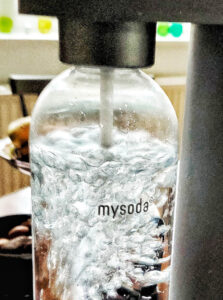
As the unit is standalone, with no need for electrical connections, and is light-weight, even with the cylinder installed, it can easily be moved around the house. But from our experience, it’s probably a good idea to check the cylinder connection when you do this.
One other small gripe. We’ve mentioned that the plain water should only fill about three-quarters of the bottle. Although a certain amount of the CO2 you add will dissolve in the water to form carbonic acid (H2O + CO2 ⇔ H2CO3), some compressible air space is necessary to make room for the gas you’re going to pump in. The manufacturer provides a mark on the bottle to indicate this level—but it’s tiny! Somewhere below it, on the opposite side of the bottle, is the highly visible MySoda logo.
Why not combine the logo with the high-level mark? MySoda’s design aesthetic seems otherwise impeccable, so this was a puzzle.
Running Cost
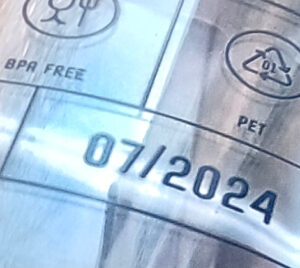
The 1L bottles have a limited life and MySoda recommends they be replaced every two to three years at a cost of about £16 a pair.
Premium versions of these bottles, with a stainless steel trim, can be had for twice the price. Why you’d want these isn’t clear to us. The expiry date is a function of the plastic container, not the trim.
On short acquaintance it’s not possible to pronounce on the below the line cost of maintenance of the Woody. But our guess, based on the simplicity of the design and the robust construction, is that this will be minimal. The ongoing consumer cost lies with the replaceable 60L CO2 cylinders.
MySoda’s recommendation is that you keep up to three “extra cylinders at home so you never run out of bubbles.” And the manufacturer’s suggestion—naturally—is that these are MySoda branded cylinders. Standard 60L cylinders from SodaStream, Philips and others will do the job equally well, but, says MySoda, “We fill the cylinders in our own factories in Finland and France using environmentally friendly wind and solar power.” The literature doesn’t say if the CO2 is captured from the air, which would keep things nicely balanced (actually this isn’t very energy efficient) or manufactured in the more usual way by burning methane.
And I wondered, as one well might, whether the environmental cost of shipping these cylinders from abroad might be counterproductive. The same thought seems to have struck MySoda, as their Website says they’re currently only delivering their own brand of cylinders to Finland.
A complete 60L cylinder from any of the sources will cost you around £22. But the empties are exchangeable and a swap runs to about half that price.
But you might have to shop around to find companies willing to exchange your MySoda cylinder. SodaStream, for example, offers an exchange program only for its own cylinders, although these are fully compatible with MySoda.
Cylinder Exchange
The UK distributors say the Woody as a full kit with a MySoda cylinder is available here in the UK and have told us these cylinders should be exchangeable for other brands once exhausted.
MySoda cylinder is available here in the UK and have told us these cylinders should be exchangeable for other brands once exhausted.
Our research of 60L cylinder exchange suggests that this isn’t the case here in the UK. Cylinder exchange is not brand-agnostic. As we haven’t been able to find any UK vendors of MySoda cylinders, if you buy the full kit complete with MySoda cylinder in the UK you’ll be left with a non-exchangeable empty that’s effectively cost you a tenner.
(We’re told that Finnish/Nordic retailers return empty cylinders to their refilling station in Finland. In France and Germany retailers send the cylinders to their refilling station in those countries.)
SodaStream seem to be the most widely trafficked 60L cylinders and their basic model is fully compatible with the Woody. This raises an interesting question, though.
In the marketing business there’s a pricing model by which you sell a cheap device (sometimes at a loss) which requires a specific consumable on which the company is going to make a very nice, long-term profit. This is called “The Razor-Razorblade Model“, and is attributed to King Gillette (hence the name).
In its purest form the Razor-Razorblade model depends on the design of the consumable being the sole property of the original vendor. There has to be no outside competition.
Of course, this is bound to break down over time. The high profit margin attracts compatible razor blades onto the market—originally as back-street knock-offs and eventually, after a few court cases, as legitimate commodities. In the end the consumer wins. This happened with the original Nespresso pod designs and is now (amusingly) happening with Nespresso’s attempt to recapture the proprietary coffee pod market with its outrageous Vertuo line of machines, for which third party refillable pods are now available on eBay.
The fizzy water business is a strange variant of this idea. Compatible cylinders of many different brands (SodaStream, Philips, Drinkmate among others) are readily available. But the high cost of the container means that you won’t want to hoard your empties. Continued use will depend (typically—but see the next section) on continued exchange. And that exchange will lock you into a single brand until this competition-restrictive practice is put an end to. And there’s little sign of that.
An irony of selling Finnish MySoda devices into the UK market is that the very reasonable pricing of the Woody (around £75 without the CO2 cylinder) is up against SodaStream’s broadly comparable cheapest offer, the Genesis, which Amazon is currently selling for £50, a price which includes a SodaStream 60L cylinder.
This is the Razor-Razorblade model in its full glory and readers will certainly be tempted. It’s worth reading the purchasers’ reviews of the Genesis first, though.
…When we opened it, I was so embarrassed! It’s made from cheap, ugly grey plastic and is not solid in any way. Without the canister in it, it had no strength at all and would crack with any tiny pressure. Even with the canister inserted, it feels flimsy and dangerous, and it feels like you could break it every time it is used.
(In fairness, you’ll want to read the views of other Genesis purchases too, of course.)
MySoda’s Woody in no way resembles “cheap plastic”. Without the cylinder (which is never is, of course) it’s certainly light-weight but is reassuringly well-built and—a crucial point—definitely passes exacting spousal scrutiny. Very little else does, the Francino Piccino being a notable exception. Reassuringly, there is no “Get that thing out of my kitchen” about the MySoda Woody. Like the espresso machine, it’s now one of the family.
Or…
There’s another way you can make use of your exhausted CO2 cylinders. Tested Technology has been in correspondence with an eBay vendor who tells us he can “refill any brand”. He’s Stephan J. Grabner of Grabner Refills Ltd in Abergavenny.
The idea is that you courier your empties to him, he refills them with food-grade CO2 and returns them to you by the same means. As these cylinders are relatively heavy I had imagined transport would be significant factor here. Stephan, however, tells me that shipping a couple of empty cylinders to him using a carrier like Yodel or Hermes should only cost around £3.00, He’ll refill the two cylinders for a total of £21, which also covers the return shipping cost. That means he’s offering refills of any brand of 60L cylinder for £12 each. This turns out to be competitive with the standard price of a SodaStream refill—in fact it’s almost £1 cheaper.
Of course, if you’re lucky enough to live in or around Abergavenny, or have an equivalent service near you, without the shipping costs refilling your own cylinders rather than exchanging could work out even cheaper.
As well as eBay you can deal directly with Stephan from his Website.
Winding Up
You can learn more about carbon dioxide here. The MySoda Woody is a handsome kitchen utensil that could save you (and the planet) a lot of aggro for a very modest outlay. Will it change your life? Probably not. But what it has done here at Tested Technology Towers is get the family drinking significantly more water.
Tap water with added carbon dioxide is a very pleasant drink. Its slight acidity won’t—as you may have read somewhere on the Internet—in any way damage your teeth. Tested Technology makes no special magical claims for it but there is some evidence that plain carbonated water allays hunger by helping the stomach feel full and so is likely to be helpful for weight-watchers.
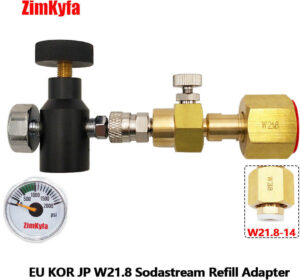
We like our brew very lightly carbonated—just one short stab on the Woody fizz-button. The corollary of this is that we’re likely to get our full 60L out of each cylinder. And what will this cost us?
The very cheapest sparkling water from Tesco is 36p per litre. Water from the tap is about 0.1p a litre. Worst case: if we only get 40L from a CO2 cylinder costing around £20 our resulting beverage will run us something very close to Tesco’s price. But that’s not including the discount of around £10 on the CO2 cylinder and the to and fro car travel between the house and Tesco.
It’s fair to conclude that fizzing your own water is cheaper than even Tesco’s budget prices (and very much cheaper than the posh brands).
If you really want to push the cost down further there are plenty of YouTube videos showing how to adapt your gasser to take much larger (and much more economical) CO2 cylinders. Alternatively, refill your existing 60L cylinder yourself, using an adaptor. The one illustrated here costs around £14, including the postage from China.Tested Technology hasn’t ventured into any of this and it’s not something we’re recommending.
Chris Bidmead
